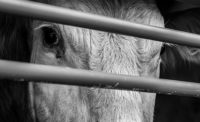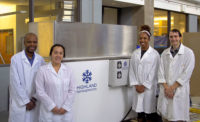Farm to Plate
Research Perspective: LAPS could set humane standard
Poultry stunning method continues to gain support as an innovative way to humanely stun animals for slaughter.




The aim behind humane methods of slaughter in processing plants is to ensure the welfare of any animal subject to pre-slaughter stunning by means of diminishing stress levels and eliminating any pain felt during slaughter.
To sustain these criteria for humane slaughter is the drive behind a remarkable and novel system, called Low Atmospheric Pressure Stunning (LAPS). This technology completely eliminates the use of gas stunning and live shackling, which are usually compromising factors to the bird’s welfare. In addition, LAPS holds the capacity to drastically reduce slaughter costs while improving worker safety, and it could set the standard of humaneness achieved during slaughter of poultry in modern processing plants.
We had the opportunity to reach out to Randolph Cheek, manager of Techno Catch LLC (owners of the technology), to learn more about the origin, research & development, and current state of LAPS. Cheek has been close to this technology since its inception. The origins of LAPS trace back to the early 1990s, when Hollis Cheek, Randolph’s father, and Bruno Cattaruzzi, of Cattaruzzi International (an Italian poultry-processing equipment co.) began to ponder methods of poultry stunning alternative to electricity or controlled-atmosphere, gas-stunning systems. Having previous experience with aviation, Cheek was well aware of how altitudes greater than 12,000 feet can affect a biological system. This marked the beginning of investigation into low atmospheric pressure stunning.
The pilot prototype system was tested for the first time in June 2005. Cheek described this mockup as a simple, cylindrical-like structure with viewing access through a window at the top. The basic method of this stunning technique was to drop atmospheric pressure in the chamber, containing the bird, by pulling the atmospheric gases from the chamber with a vacuum pump, rendering the animal unconscious, and eventually to a state of non-recovery.
Dr.Yvonne Vizzier-Thaxton, Director of the Center for Food Animal Wellbeing at the University of Arkansas, also has been a part of this technology from the start. She and her late husband, Dr. J. Paul Thaxton, organized over a dozen pilot trials and published studies to optimize the LAPS system. As she reflected on her early experience with LAPS, Dr. Vizzier-Thaxton explained that she was skeptical that it would work.
To her surprise, the birds in the early trials displayed behaviors very similar to birds in gas stunning systems, which included rapid loss of posture followed by involuntary wing flapping and convulsions. Although the observed behaviors were acceptable and expected, researchers believed the rate of decompression could be optimized to further secure the welfare of the bird and prevent carcass damage. With additional equipment development, they were able to achieve this goal.
In order to bring this system into a commercial setting, TechnoCatch approached OK Foods Co., to see if the company was interested in accommodating space for the research and development of this new technology. With “No Objection” status from the USDA, TechnoCatch had the green light to run its system at the commercial level. Cheek describes this relationship as a “win-win” for both TechnoCatch and OK Foods.
Today, LAPS has attained “No Objection” status in Canada as well as the U.S., and it is currently under review by the European Commission (EC). The European Food Safety Authority (EFSA) is handling the assessment to ensure that LAPS meets animal-welfare requirements set in regulation 1099/2099 (On the protection of animals at the time of killing).
Cheek explained that “the biggest challenge was designing studies to answer EFSA’s questions,” but noted the active research effort underway to fully investigate the impact of LAPS on bird welfare. As part of regulation 1099/2009, all petitions for new stunning methods must include sound scientific evidence that animals do not suffer during the process. Cheek hopes that approval will be granted by the EC by January 2016 (after this issue goes to press).
In describing recent studies on LAPS, Cheek explains that technology used is new, extremely accurate and unbiased. In order to get a good baseline for the research, the birds were put in a dark (absent of light) holding area to calm them, then were tested in LAPS. Electroencephalogram (EEG) technology, used to monitor brain-wave activity, allowed the team to distinguish between states of awareness in the bird.
It was able to recognize that, in a dark chamber, the bird began in sleep mode, phased to sedative, anesthetized, unconscious and finally to a state of non-recovery, all in the absence of any pain response. Cheek believes the research on LAPS will help it achieve status as the most humane stunning system, and shall be introduced to all marketplaces.
If research continues to show a benefit to the humane handling of animals just prior to slaughter beyond current methods and systems, LAPS could set a new animal-welfare standard for the industry. NP
Looking for a reprint of this article?
From high-res PDFs to custom plaques, order your copy today!








